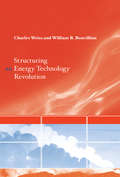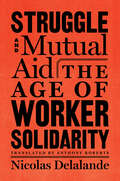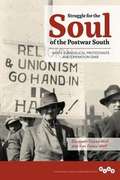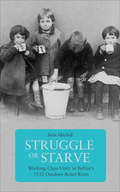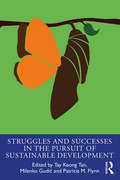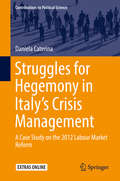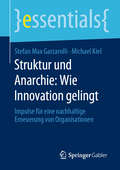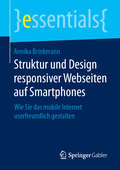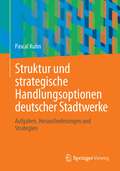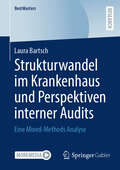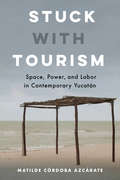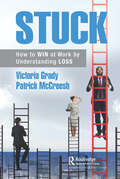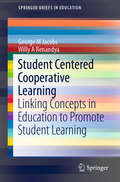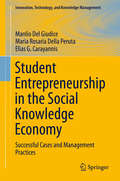- Table View
- List View
Structuring Real Estate Deals: An Investor's Perspective
by Arthur I SegelAddresses the following questions: What are the portfolio-level implications? What are the asset-level characteristics? How do I invest? With whom do I invest? What do I get for my investment? What protections do I have? When and how do I get out?
Structuring an Energy Technology Revolution (The\mit Press Ser.)
by William B. Bonvillian Charles WeissAn argument for a major federal program to stimulate innovation in energy technology and a proposal for a policy approach to implement it.America is addicted to fossil fuels, and the environmental and geopolitical costs are mounting. A public-private program—at an expanded scale—to stimulate innovation in energy policy seems essential. In Structuring an Energy Technology Revolution, Charles Weiss and William Bonvillian make the case for just such a program. Their proposal backs measures to stimulate private investment in new technology, within a revamped energy innovation system. It would encourage a broad range of innovations that would give policymakers a variety of technological options over the long implementation period and at the huge scale required, faster than could be accomplished by market forces alone. Even if the nation can't make progress at this time on pricing carbon, a technology strategy remains critical and can go ahead now.Strong leadership and public support will be needed to resist the pressure of entrenched interests against putting new technology pathways into practice in the complex and established energy sector. This book has helped start the process.
Structuring the Opportunity Space: How GE Healthcare Found Imagination Breakthroughs Through Defining a New Growth Platform
by Erich JoachimsthalerBy themselves, new opportunities for innovation and growth do not create value-they must be executed. By themselves, they do not lead to productive change and sustainable customer advantage-they must be executed. The demand-first innovation and growth model not only helps you identify opportunities for innovation, but enables you to restructure and recalibrate the opportunity space (by identifying demand-first growth platforms), and formulate a strategic blueprint for action.
Struggle and Mutual Aid: The Age of Worker Solidarity
by Nicolas DelalandeA dynamic historian revisits the workers&’ internationals, whose scope and significance are commonly overlooked.In current debates about globalization, open and borderless elites are often set in opposition to the immobile and protectionist working classes. This view obscures a major historical fact: for around a century—from the 1860s to the 1970s—worker movements were at the cutting edge of internationalism. The creation in London of the International Workingmen&’s Association in 1864 was a turning point. What would later be called the &“First International&” aspired to bring together European and American workers across languages, nationalities, and trades. It was a major undertaking in a context marked by opening borders, moving capital, and exploding inequalities. In this urgent, engaging work, historian Nicolas Delalande explores how international worker solidarity developed, what it accomplished in the nineteenth and twentieth centuries, and why it collapsed over the past fifty years, to the point of disappearing from our memories.
Struggle for the Soul of the Postwar South: White Evangelical Protestants and Operation Dixie
by Elizabeth A. Fones-Wolf Ken Fones-WolfIn 1946, the Congress of Industrial Organizations (CIO) undertook Operation Dixie, an initiative to recruit industrial workers in the American South. Elizabeth and Ken Fones-Wolf plumb rarely used archival sources and rich oral histories to explore the CIO's fraught encounter with the evangelical Protestantism and religious culture of southern whites. The authors' nuanced look at working class religion reveals how laborers across the surprisingly wide evangelical spectrum interpreted their lives through their faith. Factors like conscience, community need, and lived experience led individual preachers to become union activists and mill villagers to defy the foreman and minister alike to listen to organizers. As the authors show, however, all sides enlisted belief in the battle. In the end, the inability of northern organizers to overcome the suspicion with which many evangelicals viewed modernity played a key role in Operation Dixie's failure, with repercussions for labor and liberalism that are still being felt today. Identifying the role of the sacred in the struggle for southern economic justice, and placing class as a central aspect in southern religion, Struggle for the Soul of the Postwar South provides new understandings of how whites in the region wrestled with the options available to them during a crucial period of change and possibility.
Struggle or Starve: Working-Class Unity in Belfast's 1932 Outdoor Relief Riots
by Seán Mitchell&“A fascinating account of . . . Catholic and Protestant workers coming together to protest against a harsh state relief program&” (Belfast Telegraph). In October 1932, the streets of Belfast were gripped by vicious and widespread rioting that lasted the best part of a week. Thousands of unarmed demonstrators fought extended pitched battles against heavily armed police. Unemployed workers and, indeed, whole working-class communities, dug trenches and built barricades to hold off the police assault. The event became known as the Outdoor Relief Riot—one of a very few instances in which class sympathy managed to trump sectarian loyalties in a city famous for its divisions. &“This is an important story to tell, part of our lost history. It shows that the interests workers share far outweigh the artificial divisions of sectarianism. It is brilliant that Seán Mitchell has brought these great events backs to life. It will be an inspiration to unite again in today&’s struggles.&” —Ken Loach, two-time winner of the Palme d&’Or at the Cannes Film Festival &“Seán Mitchell&’s blow by blow account of the great Belfast Outdoor Relief workers&’ strike of 1932 masterfully recreates the drama of events as they unfolded, telling the story as it has never been told before, and in a way that is both intellectually rigorous and profoundly humane.&” —Mike Milotte, award-winning journalist and author of Banished Babies: The Secret History of Ireland&’s Baby Export Business &“Mitchell&’s book is an outstanding testimony to the centrality of united working class struggle, just as relevant today in the light of the Good Friday power sharing agreement which has institutionalized the sectarian divide.&” —Socialist Review
Struggles and Successes in the Pursuit of Sustainable Development (The Principles for Responsible Management Education Series)
by Patricia M. Flynn Tay Keong Tan Milenko GudićThe challenges associated with the struggles for attainment of the Sustainable Development Goals (SDGs) and objectives are as diverse and complex as the variety of human societies, national conditions and natural ecosystems worldwide. Despite decades of economic growth and technological advances, our world is plagued by poverty, hunger, disease, conflicts and inequality, and many societies are under the strain of environmental changes and governance failure. Such global-scale challenges call for the SDGs to be translated beyond bold concepts and aspirational targets into concrete programs and feasible plans that are substantively valuable, locally acceptable, pragmatic and operationally implementable. In the pursuit of the SDGs, positive results are far from guaranteed. Success is uncertain. Instead, the path forward requires difficult learning, experimentation and adaptation by multiple stakeholders. Loss and sacrifice are foreseeable and often inevitable. This important book captures the lessons from ongoing struggles and the early successes. Productive failures and emerging practices are identified, analyzed and promulgated for interdisciplinary learning by, and for the inspiration of, like-minded individuals, organizations, communities and nations worldwide. They can also inform and enrich the curricula in universities, training institutions and schools to prepare future generations of citizens, leaders and activists with the ethos and values of sustainability and social responsibility. The book offers a platform for academics, practitioners and concerned global citizens to identify pathways forward on the immense challenges of sustainability.
Struggles for Hegemony in Italy’s Crisis Management: A Case Study On The 2012 Labour Market Reform (Contributions To Political Science Ser.)
by Daniela CaterinaThis book investigates the struggles for hegemony, and a possible ‘crisis of crisis management’ at the core of Italy’s political economy. With a specific focus on the conflict over the 2012 labour market reform, the book also explores the country’s trajectory in the area of economic and social reproduction. It presents a framework for critical policy analysis that draws on cultural political economy and explores its potential synergies with complementary approaches such as historical materialist policy analysis and critical discourse analysis. Readers will gain an understanding of crisis dynamics in the aftermath of 2008, and insights into related political reactions. The book will also help them develop the analytical tools needed to make sense of these puzzling phenomena.
Struggling Boards: The Case for Design
by Jay W. Lorsch Colin B. CarterEven the boards that have adopted new ideas and best practices for board improvement are struggling to accomplish their mission. This chapter examines some of the reasons best practices fall short of expectations, illustrating the need for better board design, particularly in the face of 21st -century business challenges.
Struktur und Anarchie: Impulse für eine nachhaltige Erneuerung von Organisationen (essentials)
by Stefan Max Garzarolli Michael KielWie kann ich Innovation in meinem Unternehmen abbilden? Diese Frage beschäftigt Unternehmenslenker, Leiter von Fach- oder HR-Abteilungen und jeden Mitarbeiter, der sich frischen Wind am Arbeitsplatz wünscht, gleichermaßen. Sogar Start-ups geraten nach dem ersten Wurf häufig in eine Entwicklungskrise. Unsere Erfahrungen zeigen: Es gibt kein Rezept für Innovation, höchstens Muster: Erfolgreiche Innovationsprojekte werden innerhalb einer Organisation entwickelt und erfordern ein hohes Maß an Freidenken sowie motivationaler Voraussetzungen. Ein Unternehmen ist gefordert, den nötigen Raum dafür zu schaffen. Wie das im Alltag gelingen kann, wird in diesem Buch beschrieben.
Struktur und Design responsiver Webseiten auf Smartphones: Wie Sie das mobile Internet userfreundlich gestalten (essentials)
by Annika BrinkmannAnnika Brinkmann zeigt in diesem essential, wie mit wenigen Kniffen aus schlechten Beispielen gute mobile Webseiten entstehen können. Die Autorin erläutert, was getan werden muss, um Inhalte nicht zu klein oder zu groß für den verfügbaren Platz darzustellen, Navigationen sinnvoll zu strukturieren und von der richtigen Seite her einzublenden. Kurzum: Sie zeigt, wie man mobile Websites übersichtlich gestaltet, damit diese keinen User-Frust auslösen. Das mobile Internet hat die Nutzung von Webseiten auf Desktop-Computern längst hinter sich gelassen. „Mobile first“ ist angesagt, die Zeichen stehen oftmals sogar auf „Mobile only“-Nutzung des Internets – zumindest im Privatgebrauch.
Struktur und strategische Handlungsoptionen deutscher Stadtwerke: Aufgaben, Herausforderungen und Strategien
by Pascal KuhnStadtwerken mit ihren oft mannigfachen Geschäftsbereichen wie Energieerzeugung, öffentlicher Nahverkehr, Netzbetrieb Strom/Gas/Wasser, dem Vertrieb von Strom oder Gas sowie dem Ausbau/Betrieb von Ladeinfrastruktur kommt eine maßgebliche Rolle bei der konkreten & lokalen Umsetzung von Nachhaltigkeitsprojekten zu. Gleichzeitig stehen Stadtwerke in ihren Geschäftsfeldern vielfältigen Herausforderungen gegenüber, die durch verschiedene strategische Ausrichtungen und Schwerpunktsetzungen beantwortet werden können. In der vorliegenden Arbeit wird die marktübliche Struktur von Stadtwerken anhand eines Vier-Säulen-Modells archetypisch vorgestellt, um die Geschäftsfeld-spezifischen, aber auch übergreifenden Problemstellungen zu beleuchten. Anschließend werden Handlungsoptionen und grundlegende strategische Positionierungen von Stadtwerken anhand eines Drei-Akteurs-Konzeptes diskutiert. Zielsetzung ist es, einen strukturierten Überblick der deutschen Stadtwerke-Landschaft sowie durch das Aufzeigen grundlegender strategischer Handlungsoptionen Entscheidern einen auf reale Problemstellungen übertragbaren Handlungsrahmen zur Verfügung zu stellen.
Strukturaufstellungen für Konflikte, Mobbing und Mediation: Vom sichtbaren Unsichtbaren
by Christa KolodejDieses Buch veranschaulicht in der 2., aktualisierten und erweiterten Auflage die konkrete Vorgehensweise für das lösungsfokussierte Konfliktmanagement, die Mediation sowie die Systemischen Strukturaufstellungen und zeigt dabei Synergien auf. Nach einem Geleitwort von Dipl.-Psych. Insa Sparrer und Prof. Dr. Matthias Varga von Kibéd werden in acht fundierten Kapiteln unterschiedliche Konzepte vorgestellt, die von der klassischen Mediation und neuen Modellen der Anwendung über zentrale Frage- und Settingtechniken bis hin zur Umsetzung in der Einzelarbeit reichen. Das Buch richtet sich an Unternehmenspraktiker und Experten und bietet Einblick in die wirkungsvollen Systemischen Strukturaufstellungsformate, die sich in der Mediation und im Konfliktmanagement besonders bewährt haben. Fallbeispiele und direkte Handlungsempfehlungen unterstützen dabei die Formate in den eigenen Beratungskontext zu übertragen.
Strukturgleichungsmodellierung: Eine anwendungsorientierte Einführung in die Kausalanalyse mit Hilfe von AMOS, SmartPLS und SPSS
by Marko Sarstedt Rolf WeiberStrukturgleichungsmodelle stellen das Standardinstrument zur empirischen Prüfung von hypothetisierten Beziehungen zwischen theoretischen Konstrukten (latenten Variablen) dar. Das Buch zeichnet den gesamten Prozess der Strukturgleichungsmodellierung von der Konzeptualisierung theoretischer Konstrukte über die Spezifikation von Messmodellen, die Reliabilitäts- und Validitätsprüfung mittels konfirmatorischer Faktorenanalyse bis hin zur Prüfung von kausalen Wirkungshypothesen auf Basis der Kovarianzstrukturanalyse sowie der Partial Least Squares-Pfadmodellierung nach.Die einzelnen Analysen werden so erläutert, dass geringstmögliche mathematische Vorkenntnisse erforderlich sind. Alle Arbeitsschritte werden an einem durchgehenden Fallbeispiel unter Verwendung von SPSS, AMOS und SmartPLS veranschaulicht. Zu allen Arbeitsschritten werden klare Anwendungsempfehlungen sowie Hinweise zum Umgang mit unerwarteten Analyseergebnissen gegeben. Die Verwendung der jeweiligen Software wird ausführlich durch Screenshots erläutert. Für die 3. Auflage wurde das Buch umfassend überarbeitet, um die jüngsten methodischen Entwicklungen abzudecken. Besonderer Fokus wurde auf die Ausführungen zur PLS-Pfadmodellierung und Darstellung alternativer Schätzverfahren der Kausalanalyse gelegt. Das Angebot wurde zudem um digitale Lernkarten (Flashcards) erweitert, welche es dem Leser ermöglichen, das Wissen aus dem Buch zu vertiefen.Die ZielgruppenDas Buch richtet sich an Studierende und Lehrende in Master- und Doktorandenprogrammen sowie an Anwender aus der Unternehmens- und insbesondere Marktforschungspraxis. Es ist von besonderem Nutzen für alle, die Wirkungshypothesen zwischen latenten Variablen empirisch prüfen möchten. Das Fallbeispiel ist so allgemein gehalten, dass der Anwender die Analysen leicht auf spezifische Fragen und Probleme in seinen jeweiligen Anwendungsfeldern übertragen kann.Über die Internetseite www.strukturgleichungsmodellierung.de haben die Leserinnen und Leser Zugriff auf alle im Buch verwendeten Datensätze und Analyseskripte sowie weitere Serviceleistungen.
Strukturwandel im Krankenhaus und Perspektiven interner Audits: Eine Mixed-Methods Analyse (BestMasters)
by Laura BartschDer Gesundheitssektor steht vor komplexen Herausforderungen und Veränderungen, die durch dynamische Umstrukturierungen bewältigt werden können. Eine agile Arbeitsweise ermöglicht hierbei eine flexible Anpassungsfähigkeit. Besonders im Fokus steht das Qualitätsmanagement in Krankenhäusern, wobei interne Audits und deren Prüfprozesse betrachtet werden. Um die Patienten- und Qualitätssicherung zu optimieren und auf kontinuierliche Veränderungen zu reagieren, bietet die agile Auditierung mit einem iterativen Ansatz großes Potenzial.
Stryker Corp.: In-sourcing PCBs
by Timothy A. LuehrmanExamines a proposed investment in the capability to manufacture printed circuit boards (PCBs) in-house rather than buying them from third-party contract manufacturers. Stryker Corporation's Instruments business is considering the proposal in response to difficulties with existing suppliers. Requires students to formulate and execute basic quantitative capital budgeting analyses, specifically, to compute net present value (NPV) internal rate of return (IRR) and payback period.
Stryker Corporation: Capital Budgeting
by Timothy A. LuehrmanExamines some parts of Stryker Corporation's systems and procedures for approving and authorizing capital spending of many different types, including buildings, machinery, and working capital for existing businesses, as well as transactions with third parties such as acquisitions, joint ventures, and licensing agreements. Set in early 2007, nearly two years after significant modifications in these systems and procedures. Stryker has compiled a remarkable track record of consistently high growth in profitability over more than 20 years. The modifications to its capital budgeting procedures are partly intended to support the company's efforts to continue this success.
Stuck with Tourism: Space, Power, and Labor in Contemporary Yucatan
by Matilde Córdoba AzcárateTourism has become one of the most powerful forces organizing the predatory geographies of late capitalism. It creates entangled futures of exploitation and dependence, extracting resources and labor, and eclipsing other ways of doing, living, and imagining life. And yet, tourism also creates jobs, encourages infrastructure development, and in many places inspires the only possibility of hope and well-being. Stuck with Tourism explores the ambivalent nature of tourism by drawing on ethnographic evidence from the Mexican Yucatán Peninsula, a region voraciously transformed by tourism development over the past forty years. Contrasting labor and lived experiences at the beach resorts of Cancún, protected natural enclaves along the Gulf coast, historical buildings of the colonial past, and maquilas for souvenir production in the Maya heartland, this book explores the moral, political, ecological, and everyday dilemmas that emerge when, as Yucatán’s inhabitants put it, people get stuck in tourism’s grip.
Stuck: How to WIN at Work by Understanding LOSS
by Victoria Grady Patrick McCreeshOur work life is changing. Every day new companies, technologies, and ideas emerge that impact how, where, and most importantly, why we work. Despite this exciting evolution, people remain the heart of change. People are tricky. People don’t seem to evolve as fast as global trends. People get Stuck. Teams have people moving at different speeds with different levels of adoption in our evolving workplace. Some evolve and some don’t. Teams get Stuck. Leaders, managers, and teammates struggle with this resistance and get frustrated. Frustrated people impact the performance of every organization. Organizations get Stuck. Why? The answer is deeply human and biological, rooted in the way our brain interacts with everything in the world, even work. When people feel they are losing something, they react by getting Stuck. Stuck connects over 20 years of research on our brain’s reaction to the evolving workplace with real stories of people journeying through the challenge of being Stuck. The organizations, leaders, and managers who understand these concepts will evolve with the future. Those organizations will understand LOSS as a tool to achieve business WINs. This book addresses a critical concept that closes a gap in other popular business publications. Many books tell leaders and managers the process of how to change their organizations. However, many of these books lack a key mechanism for understanding human interactions. The mechanism is a biological function developed through evolution called attachment – the human need to connect to different tangible and intangible objects for support. Attachment is the reason that people connect with leaders and corporate culture, but also what creates a deep sense of loss during even the smallest changes. Stuck offers a complete understanding of attachment and how it impacts individuals, relationships, and organizations. The root of the challenge is the human need to connect to different tangible and intangible objects for support. The basis of the need for support is grounded in our need for attachment. Those who learn to understand loss through attachment behavior and the attachments of others will succeed. In addition, this book provides original data-based evidence from assessments conducted with nearly 20,000 respondents and original stories from the application of attachment concepts in more than 150 organizations across all sectors around the globe. It shines a light on attachment and use it as a lens to better understand our workplace. Stuck is not an academic study. It is a practical guide for leading the brain through change. For the first time, the authors tell stories that demonstrate their research and offer a roadmap for how to leverage attachment research to drive business success. Stuck provides not only the deep lessons from the authors’ research, but clear steps for readers to use the lessons of attachment in their own work. In this way, the book serves as a guide to those leaders, managers, and employees who are ready to be unStuck.
Student Activity Guide for Health Science Fundamentals
by Shirley A. Badasch Doreen S. ChesebroProvides students with a variety of practice activities that include worksheets, scenarios, activities, and selected check-off sheets designed for both practice and competency assessment. These check-off sheets provided step-by-step instructions to help students perform Procedures correctly and competently. All of these activities will help students successfully learn the skills required for their respective career choices.
Student Centered Cooperative Learning: Linking Concepts in Education to Promote Student Learning (SpringerBriefs in Education)
by George M Jacobs Willy A RenandyaThis book helps teachers understand the links between cooperative learning (also known as collaborative learning and peer learning) and other student-centered approaches. It discusses cooperative learning and communities of practice; cooperative learning and neuroscience; cooperative learning and critical thinking; cooperative learning and alternative assessment; cooperative learning and multiple intelligence; cooperative learning and positive education; cooperative learning and meeting the needs of introverts; and cooperative learning and justice issues, with each chapter exploring a different aspect of how education can be student centered.If you are looking for a fresh perspective on cooperative learning, this book is for you. It helps you explore how cooperative learning is so much more than just asking students to arrange themselves in a group, and considers how cooperative learning can fit with other areas of education that you care about. Although the two authors both completed their PhDs in the West, they have taught in Asia for the past 25+ years, working with students and teachers from a wide variety of Asian and other countries, and with teachers from a very wide variety of content areas who teach students of many different ages.
Student Consumer Culture in Nineteenth-Century Oxford
by Sabine ChaoucheThis book explores students’ consumer practices and material desires in nineteenth-century Oxford. Consumerism surged among undergraduates in the 1830s and decreased by contrast from the 1860s as students learned to practice restraint and make wiser choices, putting a brake on past excessive consumption habits. This study concentrates on the minority of debtors, the daily lives of undergraduates, and their social and economic environment. It scrutinises the variety of goods that were on offer, paying special attention to their social and symbolic uses and meanings. Through emulation and self-display, undergraduate culture impacted the formation of male identities and spending habits. Using Oxford students as a case study, this book opens new pathways in the history of consumption and capitalism, revealing how youth consumer culture intertwined with the rise of competition among tradesmen and university reforms in the 1850s and 1860s.
Student Debt
by Sandy BaumThis book analyzes reliable evidence to tell the true story of student debt in America. One of the nation's foremost experts on college finance, Sandy Baum exposes how misleading the widely accepted narrative on student debt is. Baum combines data, research, and analysis to show how the current discourse obscures serious problems, risks misdirecting taxpayer dollars, and could deprive too many Americans of the educational opportunities they deserve. This book and its policy recommendations provide the basis for a new and more constructive national agenda to make paying for college more manageable.
Student Educational Loan Fund, Inc. (Abridged)
by Peter Tufano Cameron PoetzscherRick Melnick oversees the Student Educational Loan Fund (SELF), which provides loans to Harvard Business School students. SELF is changing the terms of student loans from variable-rate with semiannual payments to fixed-rate loans with equal monthly payments. Melnick must decide how to finance SELF in light of the new loan mix. SELF can use a wide range of interest rate derivative products to modify the terms of its existing financing.
Student Entrepreneurship in the Social Knowledge Economy
by Maria Rosaria Della Peruta Manlio Del Giudice Elias G. CarayannisTraditionally, the study of entrepreneurial behavior focuses on such factors as (i) the personality characteristics that distinguish the entrepreneur from non-entrepreneur and (ii) demographic characteristics such gender, age, familiar antecedents and education. With particular respect to investigating the development, acquisition, and dissemination of entrepreneurial skills and behaviors, the authors focus on the university environment, as a locus of research and innovation, where students are exposed to a wide variety of influences that are enhanced by a high degree of connectivity. The underlying theme of this volume is to develop our understanding of the sociology of student entrepreneurial behavior and in doing so attempt to synthesize literature investigating individual talent with the literature on concurrent knowledge sourcing in the pursuit of entrepreneurial activities. Specifically, the authors investigate the degree to which access to diverse knowledge (in addition to such psychological characteristics and tolerance of ambiguity and risk taking) influences the nature and probability of entrepreneurial success. Moreover, they explore the role of social media and social networking in facilitating access to distributed and disparate information and knowledge Their research addresses such timely questions as: Where do entrepreneurial opportunities come from? How can higher education best stimulate the creation of firms emanating from young and smart minds in colleges and universities? What is the value of MOOCs for frequent, early, and "thick" communication among the various specialties needed to accomplish entrepreneurial projects? How do we know whether social media affect students' responses to new knowledge and new ideas? To what extent do educational practices affect racial and ethnic differences in student entrepreneurship? What is the role of the indigenous minority student entrepreneur in establishing high-technology firms? The result is a multi-dimensional approach that sheds light on the dynamics of education, knowledge creation, social networking, innovation and new business development.

